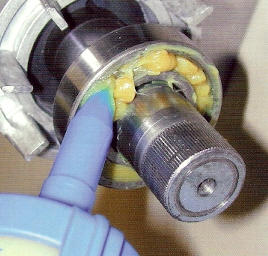 If rolling bearings are to operate reliably and realize their full service life, the must be adequately lubricated. The function of the lubricant is to form a protective oil file that separates the bearing components and prevent metal to metal contact. The lubricant also protects the bearing and related components against corrosion. When grease is used as a lubricant, it can also help protect the bearing against contaminants like dirt, dust, and water.
If rolling bearings are to operate reliably and realize their full service life, the must be adequately lubricated. The function of the lubricant is to form a protective oil file that separates the bearing components and prevent metal to metal contact. The lubricant also protects the bearing and related components against corrosion. When grease is used as a lubricant, it can also help protect the bearing against contaminants like dirt, dust, and water.
Greasing techniques vary according to the design of the bearing and its housing. However, one thing that remains constant over all bearing types is that overfilling the bearing cavity with grease will lead to increased temperatures and possible bearing failure. When greasing a bearing, be sure to leave enough space in the housing so that grease can be ejected from the bearing during start-up. In high speed electric motors, grease quantity should be kept at a low level.
Whenever, possible, open bearing should be greased after they have been mounted. Non-separable bearings, like deep groove ball bearings, angular contact ball bearings, spherical roller bearings, or toroidal roller (CARB) bearings, should be filled with grease from both sides if possible. In most cases, the space is so limited that it is not possible to grease the bearing from the side when it is mounted on the rotor. Therefore, it should be greased from the front with a grease packer, or grease gun.
Of the bearing types used in electric motor applications, only cylindrical roller bearing are separable and the most commonly used one is the NU design (two flanges on the outer ring, none on the inner ring.) The outer ring with cage and rolling elements can, and should be, greased when in the separated state during the mounting operation. Mount the inner ring on the shaft and apply a thin layer of grease to the raceway – in order to prevent scratching of the inner ring when mounting. Apply grease in the outer ring, cage and rolling elements, and make sure all spaces are well filled. Mount the outer ring in the housing (motor shield), then proceed with the assembly.
Grease Life
The life expectancy of grease products depends on several factors including the type of bearing, they type of grease, the orientation and speed of the motor, and the operating temperature of the bearings. Roller bearings, for example, have shorter relubricating intervals that ball bearings. Other factors to consider are the sealing arrangement, operating environment, and contamination.
For small ball bearings, grease life usually exceeds the service life of the motor. As a result, these bearing are usually fitted with seals or shields, and lubricated for life. However, if the grease life is shorter than the expected bearing life, the bearings need to be re-lubricated while the grease is still performing.
For more information about specific applications, please call us at 208-459-6351
